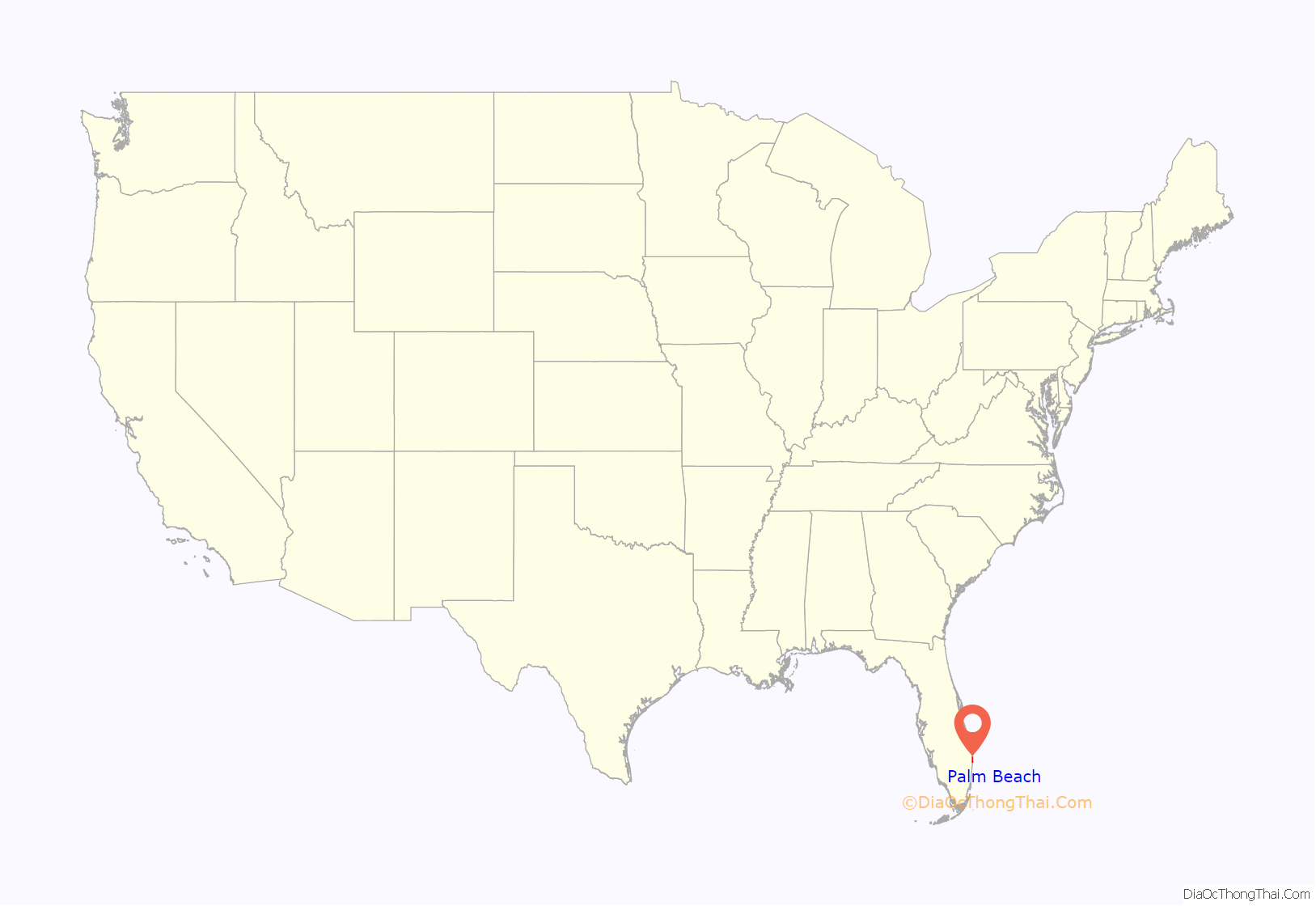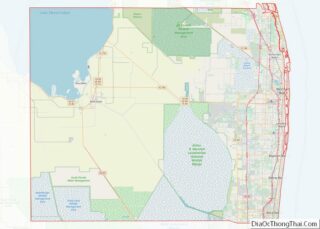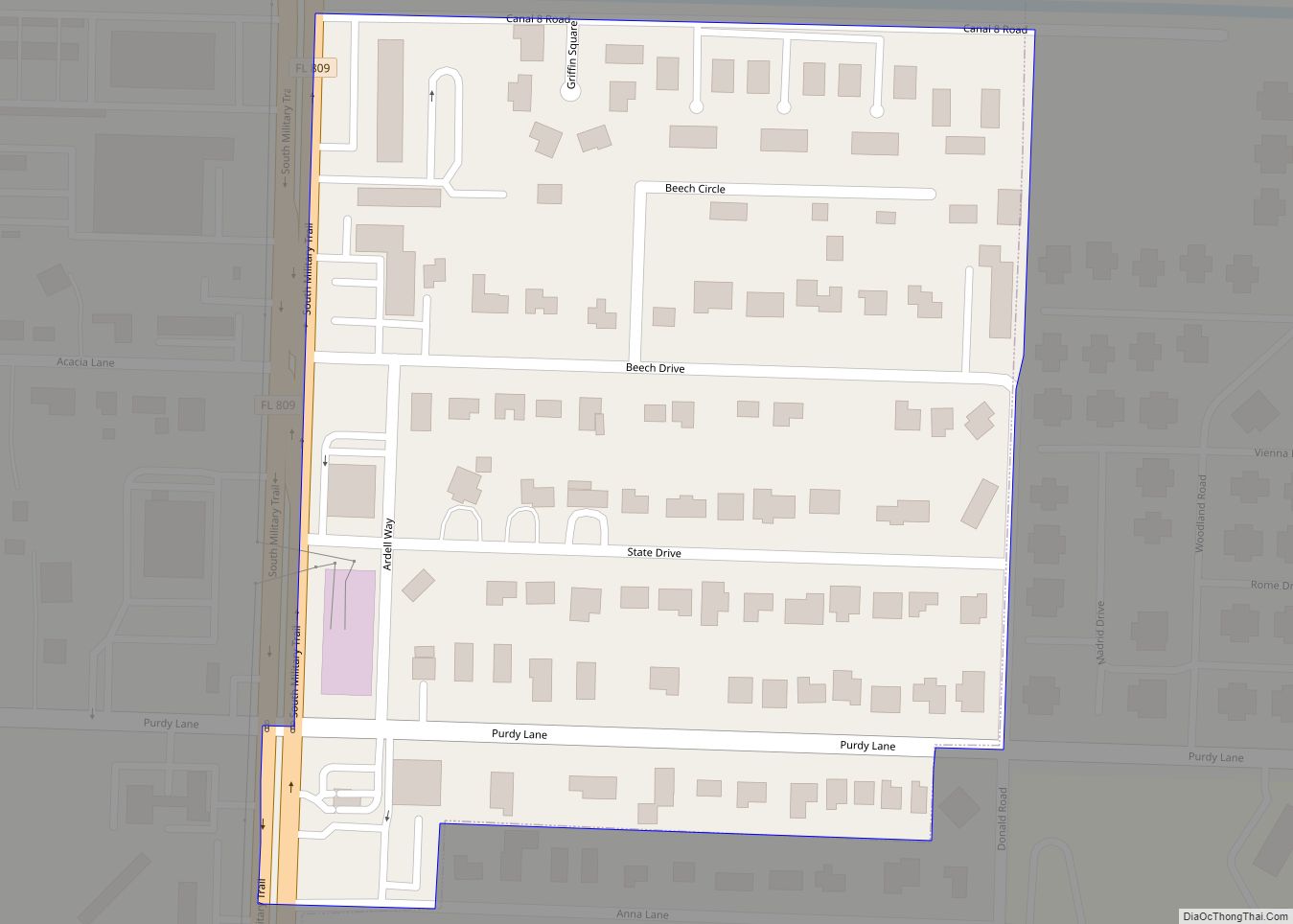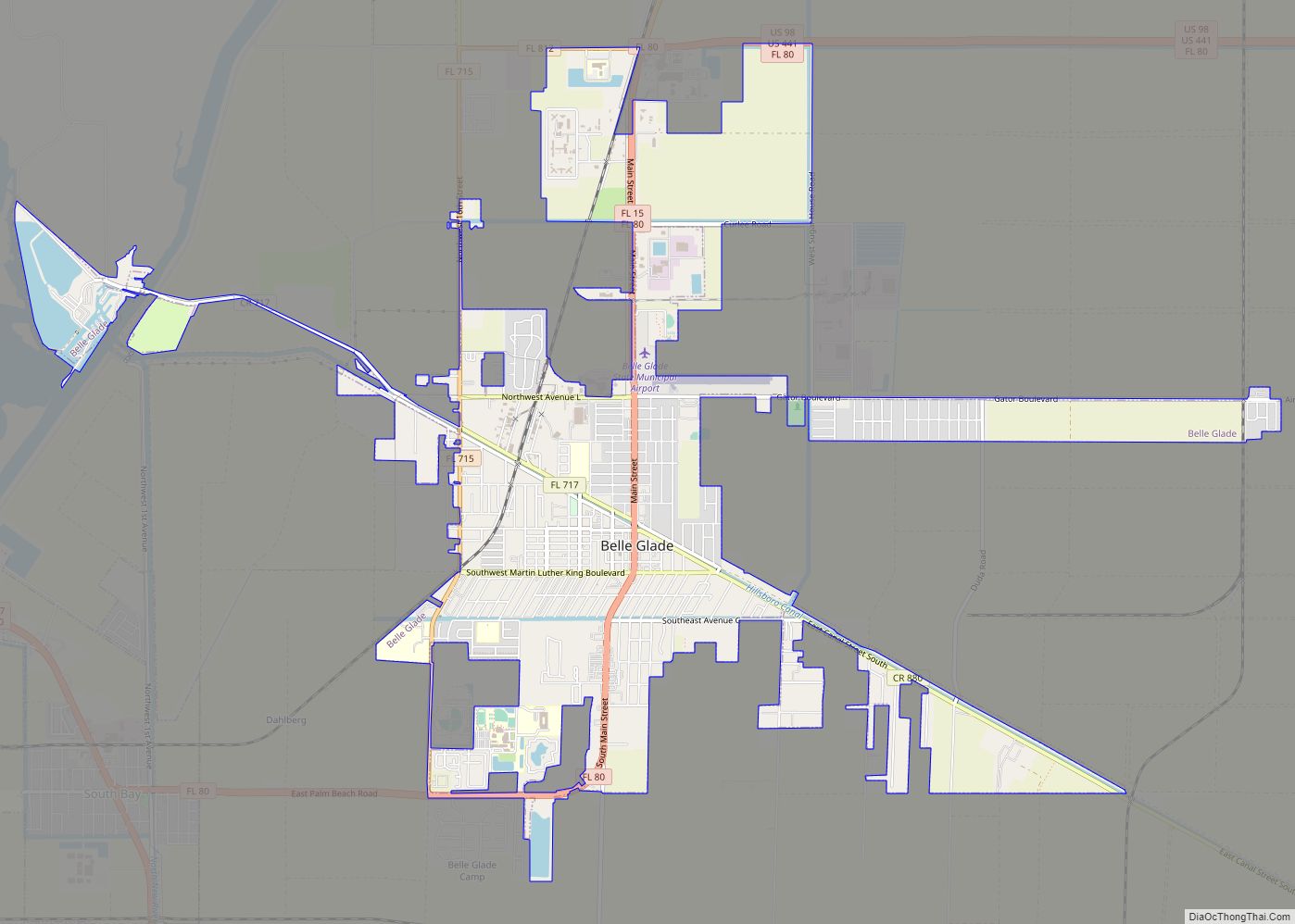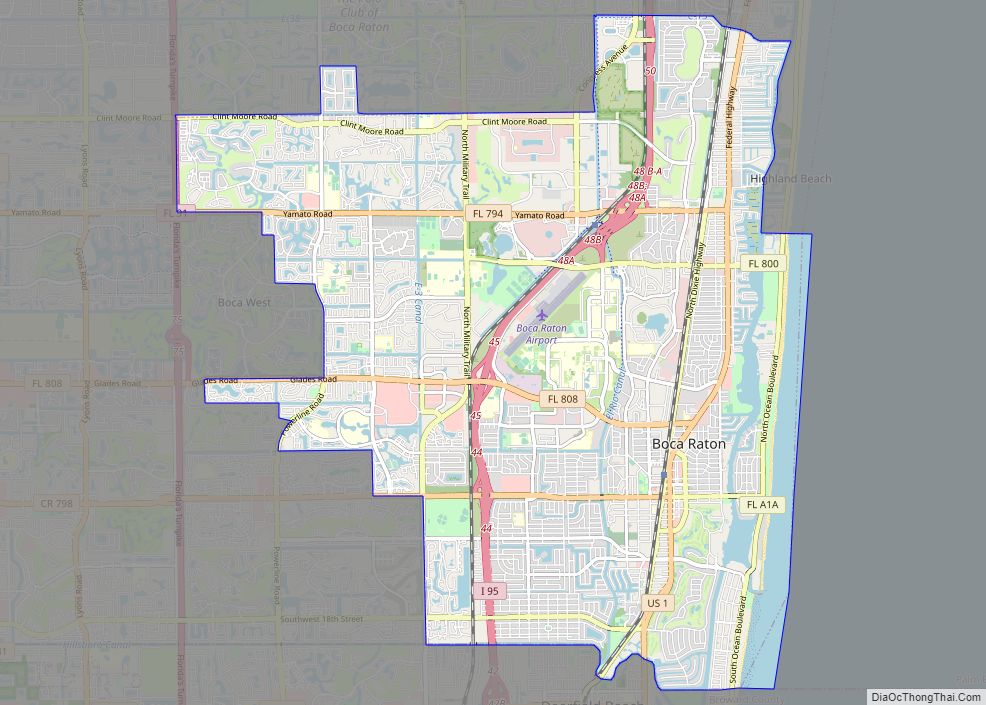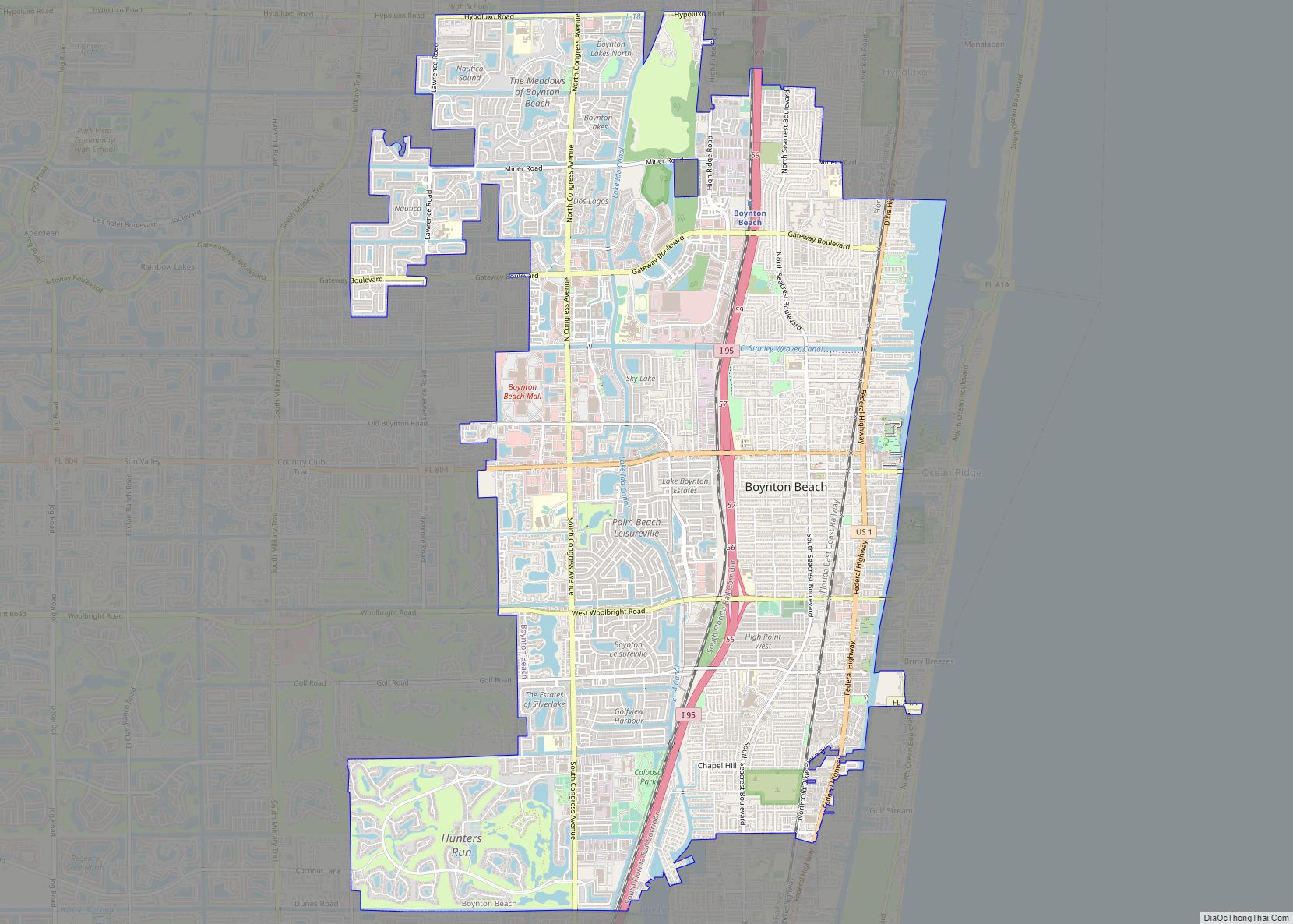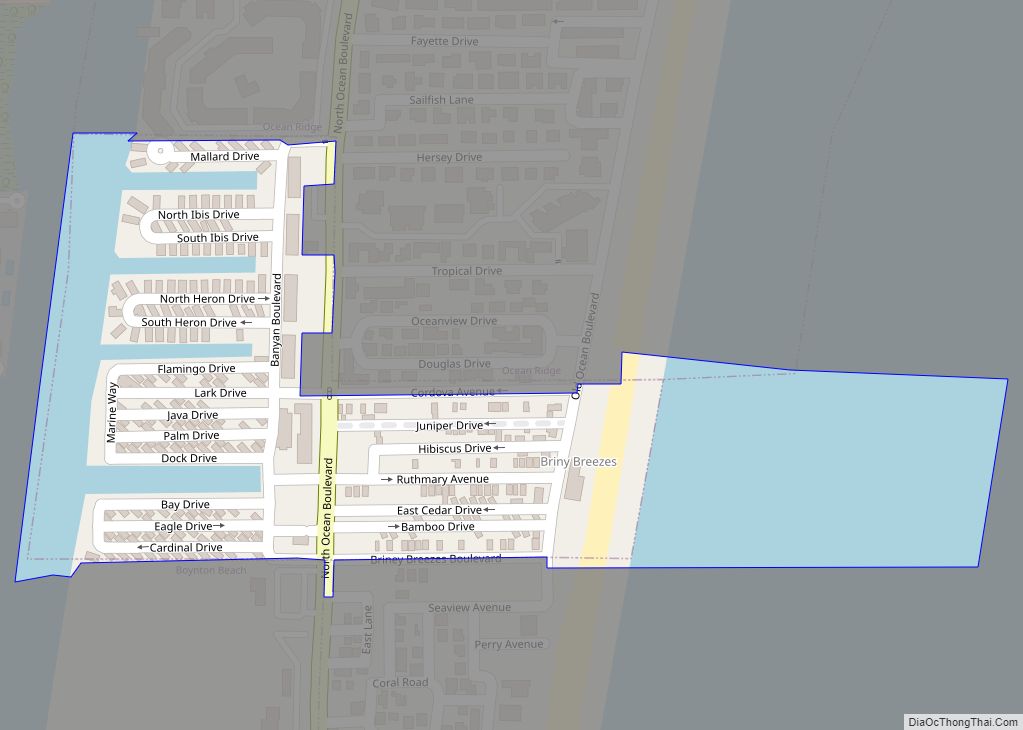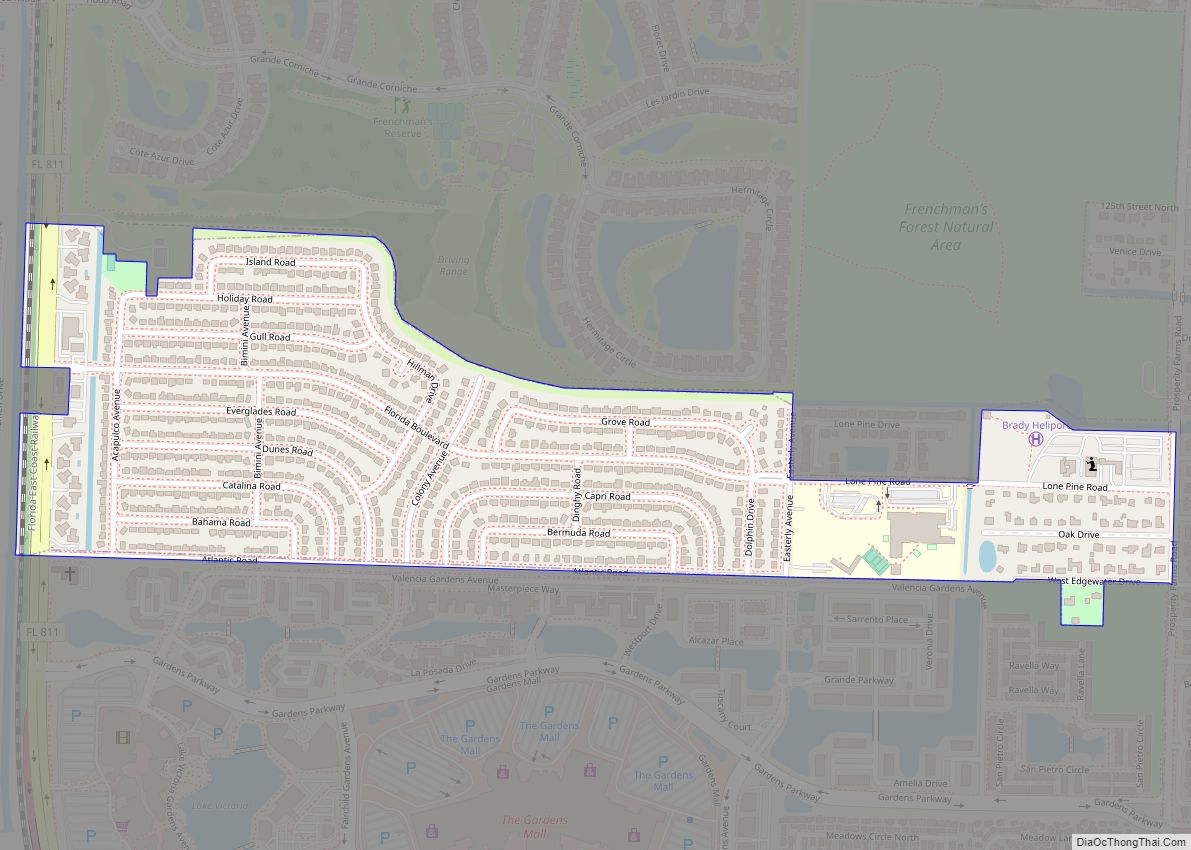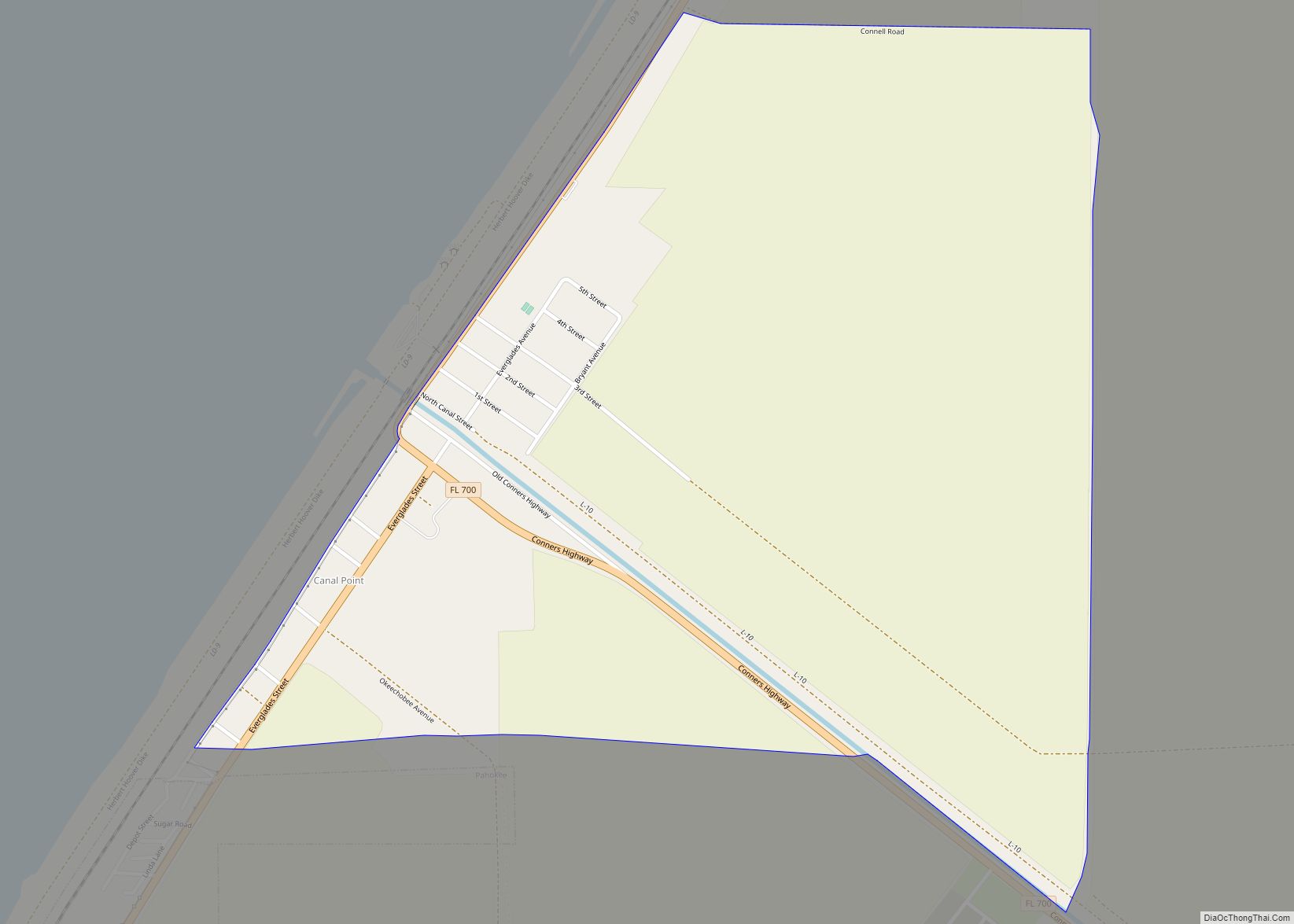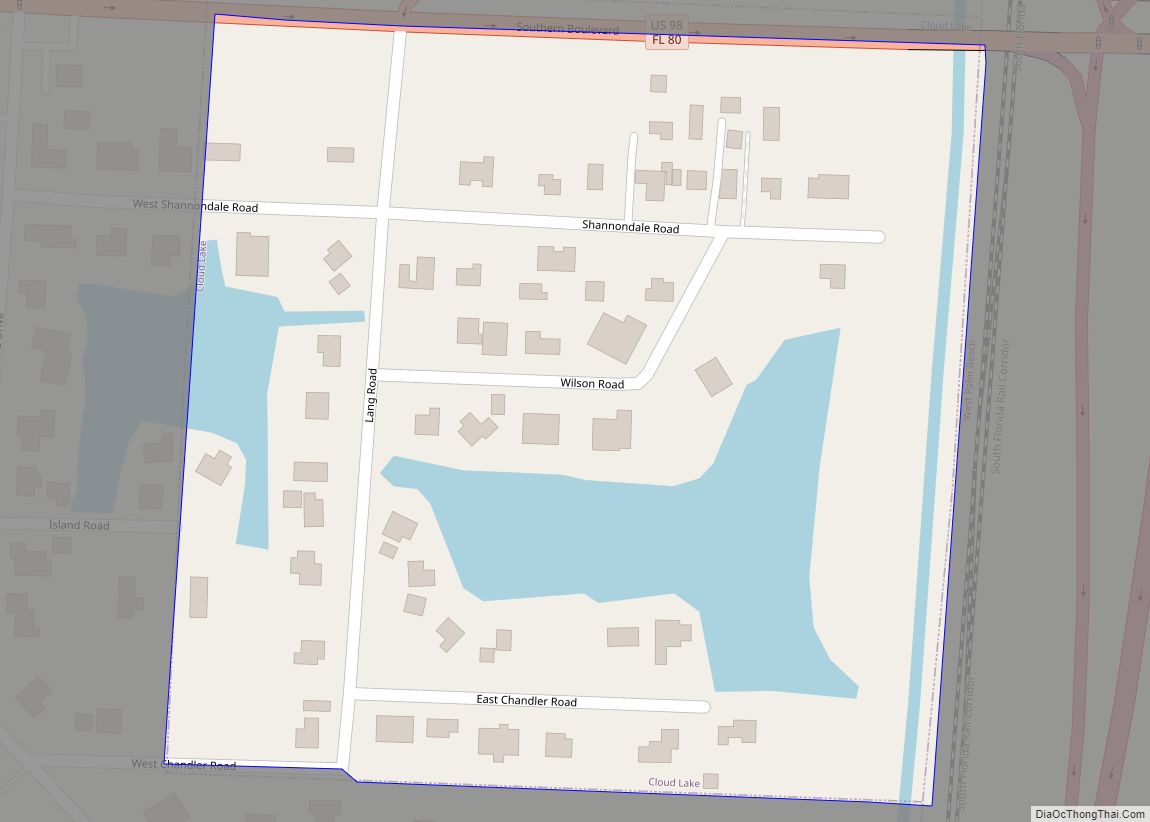Palm Beach is an incorporated town in Palm Beach County, Florida. Located on a barrier island in east-central Palm Beach County, the town is separated from West Palm Beach and Lake Worth Beach by the Intracoastal Waterway to its west and a small section of the Intracoastal Waterway and South Palm Beach to its south. As of the 2020 census, Palm Beach had a year-round population of 9,245, an increase from 8,348 people in the 2010 census. An additional 25,000 people reside in Palm Beach annually between November and April.
The Jaega arrived on the modern-day island of Palm Beach approximately 3,000 years ago. Later, white settlers reached the area as early as 1872, and opened a post office about five years later. Elisha Newton “Cap” Dimick, later the town’s first mayor, established Palm Beach’s first hotel, the Cocoanut Grove House, in 1880, but Standard Oil tycoon Henry Flagler became instrumental in transforming the island of jungles and swamps into a winter resort for the wealthy. Flagler and his workers constructed the Royal Poinciana Hotel in 1894, The Breakers in 1896, and Whitehall in 1902; extended the Florida East Coast Railway southward to the area by 1894; and developed a separate city to house hotel workers, which later became West Palm Beach. The town of Palm Beach incorporated on April 17, 1911. Addison Mizner also contributed significantly to the town’s history, designing 67 structures between 1919 and 1924, including El Mirasol, the Everglades Club, La Querida, the William Gray Warden House, and Via Mizner, which is a section of Worth Avenue.
Forbes reported in 2017 that Palm Beach had at least 30 billionaires, with the town ranking as the 27th-wealthiest place in the United States in 2016 according to Bloomberg News. Many famous and wealthy individuals have resided in the town, including United States presidents John F. Kennedy and Donald Trump. Palm Beach is known for upscale shopping districts, such as Worth Avenue, Royal Poinciana Plaza, and the Royal Poinciana Way Historic District.
| Name: | Palm Beach town |
|---|---|
| LSAD Code: | 43 |
| LSAD Description: | town (suffix) |
| State: | Florida |
| County: | Palm Beach County |
| Elevation: | 7 ft (2 m) |
| Total Area: | 7.80 sq mi (20.21 km²) |
| Land Area: | 3.80 sq mi (9.84 km²) |
| Water Area: | 4.00 sq mi (10.37 km²) |
| Total Population: | 9,245 |
| Population Density: | 2,432.25/sq mi (939.09/km²) |
| ZIP code: | 33480 |
| Area code: | 561 |
| FIPS code: | 1254025 |
| GNISfeature ID: | 288390 |
| Website: | townofpalmbeach.com |
Online Interactive Map
Click on ![]() to view map in "full screen" mode.
to view map in "full screen" mode.
Palm Beach location map. Where is Palm Beach town?
History
Native beginnings
Native Americans previously inhabited the island of Palm Beach, with the Jaegas arriving at least 3,000 years ago. Evidence for their inhabitation of the island are three pre-Columbian archaeological complexes. These complexes include a burial mound, six unmarked Native American cemeteries, and a more recent burial site which suggested interaction between indigenous people and Europeans.
1872 – 1900
Settlers began arriving in modern-day Palm Beach by 1872. Hiram F. Hammon made the first homestead claim in 1873 along Lake Worth. At the time, the lake area had fewer than 12 people. By 1877, the Tustenegee Post Office was established in modern-day Palm Beach, becoming the lake area’s first post office. Along the coast of Palm Beach, the Providencia wrecked in 1878 with a cargo of 20,000 coconuts, which were quickly planted. In 1880, Elisha Newton “Cap” Dimick converted his private residence to a hotel known as the Cocoanut Grove House. At the time of its opening, the Cocoanut Grove House was the only hotel along Florida’s east coast between Titusville and Key West. A fire destroyed the hotel in October 1893. The Star Route, also known as the Barefoot Mailman route, began serving the area in 1885. Carriers delivered mail by foot or boat from Palm Beach and other nearby communities to as far south as Miami, a round trip of 136 miles (219 km). The first schoolhouse in southeast Florida (also known as the Little Red Schoolhouse) opened in Palm Beach in 1886.
Henry Flagler, a Standard Oil tycoon, made his first visit to Palm Beach in 1893, and described the area as a “veritable paradise”. That same year, Flagler hired George W. Potter to plot 48 blocks for West Palm Beach, a city to house workers at his hotels, and construction began on the Royal Poinciana Hotel. The Royal Poinciana Hotel opened for business on February 11, 1894. Flagler, also the owner of the Florida East Coast Railway, extended the railroad southward to West Palm Beach by the following month. In 1896, Flagler opened a second hotel originally known as Wayside Inn, before being renamed Palm Beach Inn, and later becoming The Breakers. Fires later burned down the hotel in 1903 and 1925, but it was rebuilt twice. The Palm Beach Daily News began publication in 1897 originally under the name Daily Lake Worth News.
1900 – 1940
The first pedestrian bridge across the Intracoastal Waterway opened near the modern-day Flagler Bridge in 1901, replacing the original railroad spur. Flagler’s house lots were bought by the beneficiaries of the Gilded Age, and in 1902, Flagler himself built a Beaux-Arts mansion, Whitehall, designed by the New York-based firm Carrère and Hastings and helped establish the Palm Beach “winter season”. Telephone service was established in Palm Beach in 1908, with 18 customers initially. Prior to the 1910s, many African Americans in the area lived in a segregated section of Palm Beach called the “Styx”, with an estimated population of 2,000 at its peak. Between 1910 and 1912, though, African Americans were evicted from the Styx. Most of the displaced residents relocated to the northern West Palm Beach neighborhoods of Freshwater, Northwest, and Pleasant City.
In January 1911, it became known West Palm Beach intended to annex the island of Palm Beach in the upcoming Florida legislative session. Residents objected and hired an attorney from Miami to officially become incorporated. Dimick, Louis Semple Clarke, and 31 other male property owners met at Clarke’s house and signed a charter to officially incorporate the town of Palm Beach on April 17, 1911. Dimick became the first mayor, John McKenna became town clerk, and Joseph Borman became town marshal, while J. B. Donnelly, William Fremd, John Doe, Enoch Root, and J.J. Ryman served as the first council members. Also in 1911, Dimick built the Royal Park Bridge, with its first incarnation being a wooden structure. Passage from West Palm Beach to Palm Beach on the bridge originally required a toll – 25 cents per vehicle and 5 cents per pedestrian.
Between 1919 and 1924, American resort architect Addison Mizner designed 67 structures in Palm Beach. Some of Mizner’s clients included Anthony Joseph Drexel Biddle Jr., Paul Moore Sr., Gurnee Munn, John Shaffer Phipps, Edward Shearson, Eva Stotesbury, Rodman Wanamaker, and Barclay Harding Warburton II. His designed works included the Costa Bella, El Mirasol, Everglades Club (in collaboration with Paris Singer), El Solano, La Bellucia, La Querida, Via Mizner, Villa Flora, and William Gray Warden House. Via Mizner was the first shopping complex along Worth Avenue, which was then a mostly residential street.
In February 1924, the town council allotted $100,000 to construct a new municipal building. Harvey and Clarke architectural firm designed the building, while Newlon and Stephens built the structure after bidding $160,200 for the contract. The Palm Beach Town Hall opened on December 18, 1925, and is still used for town council meetings. Before its completion, the council meetings took place in a one-story wooden building on Royal Poinciana Way. Also in 1925, citywide construction revenue reached $14 million, attributed to the Florida land boom.
The 1928 Okeechobee hurricane made landfall in the town of Palm Beach, with sustained winds of 145 mph (235 km/h). High winds and storm surge damaged 610 businesses, 60 homes, and 10 hotels, as well as to the Public Service Corporation and Ocean Boulevard. Damage in 1928 dollars totaled $10 million in Palm Beach.
1940 – 1960
Palm Beach’s population grew from 1,707 in 1930 to 3,747 in 1940, a 119.5% increase. The Royal Poinciana Hotel, damaged heavily in the 1928 hurricane, also suffered greatly during the Great Depression, and was demolished in 1935. Around 4,000 people purchased the salvageable remains of the hotel. The Palm Beach-Post Times estimated some 500 homes could be built from the scraps of the hotel. Residents of Palm Beach established the Society of the Four Arts on January 14, 1936, with Hugh Dillman as the first president. The 1930s decade also saw the construction of the Flagler Memorial Bridge, the northernmost bridge linking Palm Beach and West Palm Beach, completed on July 1, 1938. Palm Beach mayor James M. Owens acted as master of ceremonies for the bridge’s opening, while then-U.S. senator Charles O. Andrews and former U.S. senator Scott Loftin gave speeches during the event.
Early in World War II, the United States Army established a Ranger camp at the northern tip of the island, which could accommodate 200 men. The Palm Beach Civilian Defense Council ordered blackouts in Palm Beach beginning on April 11, 1942. Throughout the war, German U-boats sank 24 ships off Florida, with eight capsized off Palm Beach County between February and May 1942. The Army converted The Breakers into the Ream General Army Hospital, while the Navy converted the Palm Beach Biltmore Hotel into a U.S. Naval Special Hospital. The Biltmore Hotel would also become a training school for SPARS, the United States Coast Guard Women’s Reserve.
On September 15, 1950, the Southern Boulevard Bridge opened, the third and southernmost bridge linking Palm Beach and West Palm Beach. Palm Beach residents elected Claude Dimick Reese (son of former mayor T.T. Reese and grandson of Dimick) as mayor in 1953. He became the only native-born mayor of Palm Beach in its history. In the 1950s, the town’s population grew around 56%, from 3,866 in 1950 to 6,055 in 1960.
1960 – 1990
John F. Kennedy was elected President of the United States in 1960, and selected La Querida as his Winter White House, which his father bought in 1933. In December 1960, police in Palm Beach averted a retired postal worker’s attempt to assassinate then president-elect Kennedy. The president also spent the last weekend of his life in Palm Beach, several days before his assassination in November 1963. Yvelyne “Deedy” Marix became the first woman elected to the town council in February 1970, and later became the first woman elected mayor of Palm Beach in 1983. Between 1971 and 1977, Earl E.T. Smith served as mayor of Palm Beach. He was previously an Ambassador of the United States to Cuba.
Preservationist Barbara Hoffstot published a book titled Landmark Architecture in Palm Beach in 1974. She personally photographed and summarized many older buildings in the town. The book also called for more awareness of and improvements to a system for protecting historic landmarks. The town council responded in 1979 by approving an ordinance establishing the Landmarks Preservation Commission, which identifies and works to protect historic structures.
General Foods and Post Cereals heiress Marjorie Merriweather Post bequeathed Mar-a-Lago to the United States upon her death in 1973, hoping it would be used as a Winter White House. The residence was returned to the Post family in 1981, before being purchased by Donald Trump in 1985 for roughly $10 million. He converted the estate into a club by 1995 and would later use Mar-a-Lago as a Winter White House during his presidency from 2017 to 2021. A nor’easter in November 1984 caused the Mercedes I to crash into the seawall of Mollie Wilmot’s estate. Wilmot’s staff served the 10 sailors sandwiches and freshly brewed coffee in her gazebo and offered martinis to journalists reporting on the incident.
1990 – 2010
On October 31, 1991, the Perfect Storm produced waves 20 feet (6.1 m) in height in Palm Beach. About 1,200 feet (370 m) of seawall at Worth Avenue were destroyed, while some parts of the town experienced coastal flooding, especially along Ocean Boulevard. By that afternoon, police allowed only residents to enter the town. The trial of William Kennedy Smith, a member of the Kennedy family, drew international media attention in 1991. Smith had been accused of committing rape at La Querida, but a trial at the Palm Beach County Court resulted in his acquittal on December 11, 1991. Another notable mayor, Paul Ilyinsky, son of Grand Duke Dmitri Pavlovich of Russia and heiress Audrey Emery, was elected to the office in February 1993. The town’s population peaked at 10,468 people in the 2000 census. In March 2005, the Palm Beach Police Department – under the guidance of Police Chief Michael Reiter – began the first inquiry into the crimes committed by sex trafficker Jeffrey Epstein, leading to his arrest and indictment in July 2006. Despite an FBI investigation discovering at least 40 victims, the state attorney of Palm Beach County only charged Epstein with soliciting a prostitute and soliciting a minor for prostitution in June 2008. He pled guilty on both counts and received a controversial plea deal.
2010 – present
The town had a population of 8,348 people in 2010, a decrease of 20.3% from the previous census. Palm Beach celebrated its centennial on April 17, 2011. About 1,200 people attended a parade that began at the Flagler Museum (Whitehall). Between February and December 2015, the Town Square, which includes the Addison Mizner Memorial Fountain and the town hall, underwent a $5.7 million restoration. The fountain’s restoration was named “project of the year” by the American Public Works Association’s Florida chapter.
Name
The January 1878 wreck of the Providencia is credited with giving Palm Beach its name. The Providencia was traveling from Havana to Cádiz, Spain, with a cargo of coconuts harvested in the Crown Colony of Trinidad and Tobago in the British West Indies, when the ship wrecked near Palm Beach. Many of the coconuts naturalized or were planted along the Palm Beach coast. A lush grove of palm trees soon grew on what was later named Palm Beach.
Palm Beach Road Map
Palm Beach city Satellite Map
Geography
Palm Beach is one of the easternmost towns in Florida, though the state’s easternmost point is in Palm Beach Shores, just north of Lake Worth Inlet. The town is on an 18-mile (29 km) long barrier island between the Intracoastal Waterway (locally known as the Lake Worth Lagoon) on the west and the Atlantic Ocean on the east. At no point is the island wider than three-quarters of a mile (1.2 km), and in places it is only 500 feet (150 m) wide. The northern boundary of Palm Beach is the Lake Worth Inlet, though it adjoined with Singer Island until the permanent dredging of the inlet in 1918. To the south, a section of Lake Worth Beach occupies the island in the vicinity of State Road 802, though an exclave of Palm Beach extends farther southward until the northern limits of South Palm Beach. According to the U.S. Census Bureau, the town has an area of 8.12 sq mi (21.0 km), with land accounting for 4.20 sq mi (10.9 km) and water covering the remaining 3.92 sq mi (10.2 km). The average elevation of the town is 7 ft (2.1 m); the highest point is 30 ft (9.1 m) above sea level on the golf course at the Palm Beach Country Club.
Geologically, the island is a sand-covered ridge of coquina rock. Before settlement, the island was a pronounced coastal ridge bordering the Atlantic Ocean. The Intracoastal Waterway coast was primarily low-lying and swampy; marshy sloughs generally lay between the two features, though an oolitic limestone ridge stood along some parts of the island’s westward side. Since 1883, the environment has been significantly altered by developing land, the filling of the sloughs, and a receding coastline due to erosion, but the Atlantic ridge is still the dominating topographical feature of the island and acts as a seaward barrier. The former slough areas are flood-prone.
The town and entire barrier island are within Evacuation Zone B, and evacuations are often ordered if a hurricane is forecast to impact the area, most recently in anticipation of Hurricane Dorian in 2019. Palm Beach town officials may deploy law enforcement officers to strategically place roadblocks to limit access to the island during unsafe conditions.
As of 2016, land use of the town is 60% residential, 13% rights-of-way, 10% private group uses, 3% recreational, 3% commercial, 2% public uses, 1% hotels (not including The Breakers), and less than 1% conservation, while The Breakers is a planned unit development accounting for 6% of land use. The remaining 2% of land was vacant. Palm Beach does not have any land dedicated to agricultural or industrial purposes. The town is essentially built out and cannot extend its boundaries.
Conservation is mainly confined to Bingham Island, Fishermen’s Island, and Hunter’s Island. Functioning as bird sanctuaries and rookeries, the islands are leased by the National Audubon Society, though state trustees of the Internal Improvement Fund and the Blossom Estate hold the titles to the islands. A part of Blossom Estate Subdivision just south of Southern Boulevard is also designated a conservation area.
Climate
According to the Köppen climate classification, Palm Beach has a tropical rainforest climate with hot, humid summers and warm, slightly dryer winters. The annual average precipitation is 62.3 in (1,580 mm), most of which occurs from May through October. In the wet summer season, short-lived heavy afternoon thunderstorms are common. Palm Beach reports more than 2,900 hours of sunshine annually. Although tropical cyclones can impact Palm Beach, strikes are rare, with the last direct hit in 1928.
The wet season is from May to October, when convective thunderstorms and downpours are common. Average high temperatures in Palm Beach are 83 to 91 °F (28 to 33 °C) with lows of 68 to 76 °F (20 to 24 °C), though low temperatures at or above 80 °F (27 °C) are not uncommon. During this period, more than half of the summer days bring occasional afternoon thunderstorms and seabreezes that somewhat cool the rest of the day. The winter brings dryer, sunny, and much less humid weather. Between December and February, average high temperatures range from 74 to 82 °F (23 to 28 °C) and low temperatures average between 57 and 68 °F (14 and 20 °C). High temperatures occasionally drop below 70 °F (21 °C), while at other times highs occasionally reach 90 °F (32 °C) in mid-winter. The highest recorded temperature, 101 °F (38 °C), occurred on July 21, 1941, while the lowest observed temperature, 24 °F (−4 °C), occurred on December 29, 1894. In some years, the dry season can become quite dry, and water restrictions are imposed.
See also
Map of Florida State and its subdivision:- Alachua
- Baker
- Bay
- Bradford
- Brevard
- Broward
- Calhoun
- Charlotte
- Citrus
- Clay
- Collier
- Columbia
- Desoto
- Dixie
- Duval
- Escambia
- Flagler
- Franklin
- Gadsden
- Gilchrist
- Glades
- Gulf
- Hamilton
- Hardee
- Hendry
- Hernando
- Highlands
- Hillsborough
- Holmes
- Indian River
- Jackson
- Jefferson
- Lafayette
- Lake
- Lee
- Leon
- Levy
- Liberty
- Madison
- Manatee
- Marion
- Martin
- Miami-Dade
- Monroe
- Nassau
- Okaloosa
- Okeechobee
- Orange
- Osceola
- Palm Beach
- Pasco
- Pinellas
- Polk
- Putnam
- Saint Johns
- Saint Lucie
- Santa Rosa
- Sarasota
- Seminole
- Sumter
- Suwannee
- Taylor
- Union
- Volusia
- Wakulla
- Walton
- Washington
- Alabama
- Alaska
- Arizona
- Arkansas
- California
- Colorado
- Connecticut
- Delaware
- District of Columbia
- Florida
- Georgia
- Hawaii
- Idaho
- Illinois
- Indiana
- Iowa
- Kansas
- Kentucky
- Louisiana
- Maine
- Maryland
- Massachusetts
- Michigan
- Minnesota
- Mississippi
- Missouri
- Montana
- Nebraska
- Nevada
- New Hampshire
- New Jersey
- New Mexico
- New York
- North Carolina
- North Dakota
- Ohio
- Oklahoma
- Oregon
- Pennsylvania
- Rhode Island
- South Carolina
- South Dakota
- Tennessee
- Texas
- Utah
- Vermont
- Virginia
- Washington
- West Virginia
- Wisconsin
- Wyoming
